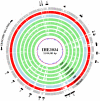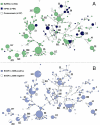Identification of protective and broadly conserved vaccine antigens from the genome of extraintestinal pathogenic Escherichia coli
- PMID: 20439758
- PMCID: PMC2889118
- DOI: 10.1073/pnas.0915077107
Identification of protective and broadly conserved vaccine antigens from the genome of extraintestinal pathogenic Escherichia coli
Abstract
Extraintestinal pathogenic Escherichia coli (ExPEC) are a common cause of disease in both mammals and birds. A vaccine to prevent such infections would be desirable given the increasing antibiotic resistance of these bacteria. We have determined the genome sequence of ExPEC IHE3034 (ST95) isolated from a case of neonatal meningitis and compared this to available genome sequences of other ExPEC strains and a few nonpathogenic E. coli. We found 19 genomic islands present in the genome of IHE3034, which are absent in the nonpathogenic E. coli isolates. By using subtractive reverse vaccinology we identified 230 antigens present in ExPEC but absent (or present with low similarity) in nonpathogenic strains. Nine antigens were protective in a mouse challenge model. Some of them were also present in other pathogenic non-ExPEC strains, suggesting that a broadly protective E. coli vaccine may be possible. The gene encoding the most protective antigen was detected in most of the E. coli isolates, highly conserved in sequence and found to be exported by a type II secretion system which seems to be nonfunctional in nonpathogenic strains.
Conflict of interest statement
Conflict of interest statement: R. Rappuoli is a full-time employee of Novartis Vaccines.
Figures




Similar articles
-
Identification of candidates for a subunit vaccine against extraintestinal pathogenic Escherichia coli.Infect Immun. 2007 Apr;75(4):1916-25. doi: 10.1128/IAI.01269-06. Epub 2006 Dec 4. Infect Immun. 2007. PMID: 17145948 Free PMC article.
-
Comparative genomic analysis shows that avian pathogenic Escherichia coli isolate IMT5155 (O2:K1:H5; ST complex 95, ST140) shares close relationship with ST95 APEC O1:K1 and human ExPEC O18:K1 strains.PLoS One. 2014 Nov 14;9(11):e112048. doi: 10.1371/journal.pone.0112048. eCollection 2014. PLoS One. 2014. PMID: 25397580 Free PMC article.
-
Prevalence of avian-pathogenic Escherichia coli strain O1 genomic islands among extraintestinal and commensal E. coli isolates.J Bacteriol. 2012 Jun;194(11):2846-53. doi: 10.1128/JB.06375-11. Epub 2012 Mar 30. J Bacteriol. 2012. PMID: 22467781 Free PMC article.
-
Global Extraintestinal Pathogenic Escherichia coli (ExPEC) Lineages.Clin Microbiol Rev. 2019 Jun 12;32(3):e00135-18. doi: 10.1128/CMR.00135-18. Print 2019 Jun 19. Clin Microbiol Rev. 2019. PMID: 31189557 Free PMC article.
-
Extraintestinal Pathogenic Escherichia coli, a Common Human Pathogen: Challenges for Vaccine Development and Progress in the Field.J Infect Dis. 2016 Jan 1;213(1):6-13. doi: 10.1093/infdis/jiv429. Epub 2015 Sep 2. J Infect Dis. 2016. PMID: 26333944 Free PMC article. Review.
Cited by
-
YghG (GspSβ) is a novel pilot protein required for localization of the GspSβ type II secretion system secretin of enterotoxigenic Escherichia coli.Infect Immun. 2012 Aug;80(8):2608-22. doi: 10.1128/IAI.06394-11. Epub 2012 May 14. Infect Immun. 2012. PMID: 22585966 Free PMC article.
-
Vaccines, reverse vaccinology, and bacterial pathogenesis.Cold Spring Harb Perspect Med. 2013 May 1;3(5):a012476. doi: 10.1101/cshperspect.a012476. Cold Spring Harb Perspect Med. 2013. PMID: 23637311 Free PMC article.
-
Genomic Insights into Drug Resistance and Virulence Platforms, CRISPR-Cas Systems and Phylogeny of Commensal E. coli from Wildlife.Microorganisms. 2021 May 5;9(5):999. doi: 10.3390/microorganisms9050999. Microorganisms. 2021. PMID: 34063152 Free PMC article.
-
Hcp family proteins secreted via the type VI secretion system coordinately regulate Escherichia coli K1 interaction with human brain microvascular endothelial cells.Infect Immun. 2012 Mar;80(3):1243-51. doi: 10.1128/IAI.05994-11. Epub 2011 Dec 19. Infect Immun. 2012. PMID: 22184413 Free PMC article.
-
Computational methods for predicting genomic islands in microbial genomes.Comput Struct Biotechnol J. 2016 May 7;14:200-6. doi: 10.1016/j.csbj.2016.05.001. eCollection 2016. Comput Struct Biotechnol J. 2016. PMID: 27293536 Free PMC article. Review.
References
-
- Kaper JB, Nataro JP, Mobley HL. Pathogenic Escherichia coli. Nat Rev Microbiol. 2004;2(2):123–140. - PubMed
-
- Blattner FR, et al. The complete genome sequence of Escherichia coli K-12. Science. 1997;277(5331):1453–1474. - PubMed
-
- Ahmed N, Dobrindt U, Hacker J, Hasnain SE. Genomic fluidity and pathogenic bacteria: applications in diagnostics, epidemiology and intervention. Nat Rev Microbiol. 2008;6(5):387–394. - PubMed
-
- Russo TA, Johnson JR. Medical and economic impact of extraintestinal infections due to Escherichia coli: Focus on an increasingly important endemic problem. Microbes Infect. 2003;5(5):449–456. - PubMed
Publication types
MeSH terms
Substances
Grants and funding
LinkOut - more resources
Full Text Sources
Other Literature Sources
Medical
Molecular Biology Databases

